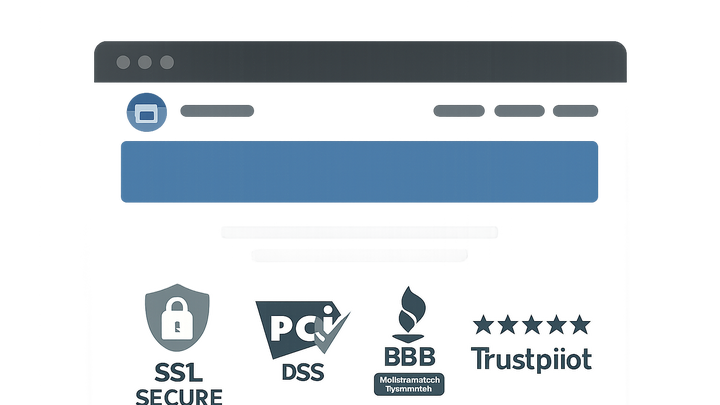Published on 2025-06-29T20:37:05Z
What are Trust Certifications? Examples and Best Practices
Trust certifications are third-party badges or seals displayed on websites to verify security, privacy, or compliance standards. Examples include SSL/TLS encryption badges, PCI DSS compliance seals, BBB Accredited Business logos, and Trustpilot ratings. By showcasing these certifications prominently, websites signal credibility, data protection, and regulatory adherence. From a CRO perspective, trust badges reduce anxiety at critical conversion points, boosting form submissions and sales. In terms of UX, well-designed and accessible badges reassure users without disrupting the interface flow. Additionally, secure and certified sites often gain a slight SEO advantage, as search engines prefer HTTPS and reputable domains. Implementing and monitoring trust certifications effectively is essential to maximize user confidence, conversions, and search visibility.
Trust certifications
Third-party badges verifying a website's security, compliance, and credibility to boost user trust, optimize conversions, and enhance SEO.
Why Trust Certifications Matter
Trust certifications are essential for building user confidence and credibility online. They act as visual cues that a website meets specific security, privacy, or quality standards. For CRO, they reduce form abandonment and increase conversions. From a UX standpoint, they reassure users at key touchpoints. In SEO terms, secure and certified sites often gain algorithmic preference.
-
Increase user confidence
Recognized badges signal credibility, making visitors more comfortable sharing personal information or making purchases.
- Security assurance:
Badges like SSL/TLS confirm data encryption, reducing fears of interception or data breaches.
- Brand credibility:
Third-party endorsements reinforce the legitimacy and professionalism of the business.
- Security assurance:
-
Improve conversion rates
Displaying trust seals near CTAs and forms lowers abandonment rates and drives higher completion rates.
- Reduced checkout drop-off:
Security badges at payment stages prevent cart abandonment by reassuring users.
- Enhanced form submissions:
Trust seals on lead generation forms increase the likelihood of users sharing contact details.
- Reduced checkout drop-off:
-
Boost seo performance
Secure sites and reputable domains are favored by search engines, improving organic rankings.
- Https ranking signal:
Google and other engines use HTTPS as a lightweight ranking factor.
- Improved crawl trust:
Certified sites often have better domain authority and link trust.
- Https ranking signal:
Common Types of Trust Certifications
There are various certifications tailored to different needs, from encryption to consumer protection. Selecting the right type depends on industry requirements and audience expectations.
-
Ssl/tls certificates
Ensure encrypted connections and display the padlock icon in browsers as a baseline trust indicator.
-
Pci dss compliance
Certifies that payment data is handled according to strict security standards, essential for e-commerce sites.
-
Third-party trust seals
Badges from organizations like BBB, Trustpilot, or Google Reviews that showcase customer satisfaction and business integrity.
-
Data privacy standards
Certifications such as GDPR or CCPA compliance that demonstrate commitment to user data protection and privacy.
Implementing Trust Certifications on Your Site
Proper implementation involves choosing relevant badges, placing them strategically, and ensuring they align with UX and accessibility best practices.
-
Selecting relevant certifications
Identify certifications that resonate with your industry and audience to maximize trust impact.
- E-commerce requirements:
Prioritize SSL/TLS, PCI DSS, and dynamic vulnerability scanning seals for online stores.
- Service providers:
Use seals like BBB accreditation or ISO certifications to validate professional services.
- E-commerce requirements:
-
Proper badge placement
Position badges near CTAs, in headers or footers, and on checkout pages to optimize visibility.
- Header and footer:
Universal placement ensures badges are seen on every page.
- Near call-to-actions:
Adjacent placement reinforces trust at decision points.
- Header and footer:
-
Accessibility and ux considerations
Ensure badges are perceivable and understandable by all users, including those using assistive technologies.
- Descriptive alt text:
Provide meaningful alt text for screen readers to convey the badge’s purpose.
- Keyboard focusable badges:
Make badges reachable via keyboard navigation to support non-mouse users.
- Descriptive alt text:
Monitoring and Optimizing Trust Certifications
Continuously evaluate the effectiveness of your trust badges through testing, analytics, and expert critiques to drive ongoing improvements.
-
A/b testing badge designs and placement
Experiment with different badge visuals and locations to determine which combinations yield the highest conversions.
- Variation tracking:
Use unique identifiers for each badge variant to measure performance accurately.
- Conversion analysis:
Correlate badge variations with form completions, sales, and engagement metrics.
- Variation tracking:
-
Using prevue.me for critiques
Leverage prevue.me to get actionable feedback on badge placement, design, UX, SEO, and accessibility.
- Cro analysis:
Receive targeted recommendations to reduce friction and increase lead generation.
- Accessibility check:
Ensure badges meet WCAG standards and are fully accessible to all users.
- Cro analysis:
-
Tracking key metrics
Monitor conversion rate, bounce rate, and session duration to assess the impact of trust certifications.
- Conversion rate:
Track the percentage of visitors who complete desired actions after viewing trust badges.
- Bounce rate:
Observe if improved trust reduces the percentage of single-page sessions.
- Session duration:
Measure if users stay longer on pages featuring trust certifications.
- Conversion rate:
